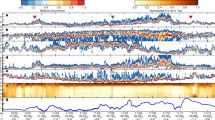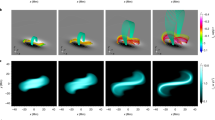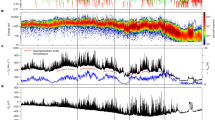Abstract
The Evershed effect1—a wavelength shift and profile asymmetry in the spectral lines observed from the outer regions of sunspots (the penumbra)—has been interpreted as a radial outflow of gas from the sunspot, but the dynamics of the flow have not been fully understood2. Although the Evershed effect seems to stop abruptly at the outer edge of the penumbra, the outflow itself must continue, though tracing its path has proved difficult. Theoretical3,4 and observational5,6,7 studies have suggested that much of the continuing flow may follow magnetic field lines that go below the visible surface of the Sun at or just beyond the edge of the penumbra, and recent observations have now confirmed this picture8. Here we show, using theoretical calculations based on a more realistic model, that the flow acts like a siphon3,9,10,11,12 which is driven along a magnetic flux tube by the pressure drop between the endpoints of the tube.
This is a preview of subscription content, access via your institution
Access options
Subscribe to this journal
Receive 51 print issues and online access
$199.00 per year
only $3.90 per issue
Buy this article
- Purchase on Springer Link
- Instant access to full article PDF
Prices may be subject to local taxes which are calculated during checkout



Similar content being viewed by others
References
Evershed, J. Radial movement in Sun-spots. Mon. Not. R. Astron. Soc. 69, 454–457 (1909).
Thomas, J. H. & Weiss, N. O. in Sunspots: Theory and Observations (eds Thomas, J. H. & Weiss, N. O.) 3–59 (Kluwer, Dordrecht, (1992).
Thomas, J. H. & Montesinos, B. Asiphon-flow model of the photospheric Evershed effect in a sunspot. Astrophys. J. 407, 398–401 (1993).
Thomas, J. H. in Solar and Astrophysical Magnetohydrodynamic Flows (ed. Tsinganos, K. C.) 39–60 (Kluwer, Dordrecht, (1996)).
Börner, P. & Kneer, F. High resolution observations of the Evershed flow. Astron. Astrophys. 259, 307–312 (1992).
Rimmele, T. R. Sun center observations of the Evershed effect. Astrophys. J. 445, 511–516 (1995).
Stanchfield, D. C. H., Thomas, J. H. & Lites, B. W. The vector magnetic field, Evershed flow, and intensity in a sunspot. Astrophys. J. 477, 485–494 (1997).
Westendorp Plaza, C. et al. Evidence for an Evershed flow returning into the Sun. Nature 389, 47–49 (1997).
Meyer, F. & Schmidt, H. U. Magnetisch ausgerichte Strömungen zwischen Sonnenflecken. Z. Angew. Math. Mech. 48, 218–221 (1968).
Thomas, J. H. Siphon flows in isolated magnetic flux tubes. Astrophys. J. 333, 407–419 (1988).
Degenhardt, D. Stationary siphon flows in thin magnetic flux tubes. II. Radiative heat exchange with the surroundings. Astron. Astrophys. 248, 637–646 (1991).
Thomas, J. H. in Solar Surface Magnetism (eds Rutten, R. J. & Schrijver, C. J.) 219–235 (Kluwer, Dordrecht, (1994)).
Schmidt, H. U. Sunspots. Geophys. Astrophys. Fluid Dyn. 62, 249–270 (1991).
Degenhardt, D. & Wiehr, E. Spatial variation of the magnetic field inclination in a sunspot penumbra. Astron. Astrophys. 252, 821–826 (1991).
Title, A. M. et al. On the magnetic and velocity field geometry of simple sunspots. Astrophys. J. 403, 780–796 (1993).
Lites, B. W., Elmore, D. F., Seagraves, P. & Skumanich, A. P. Stokes profile analysis and vector magnetic fields. VI. Fine scale structure of a sunspot. Astrophys. J. 418, 928–942 (1993).
Rimmele, T. R. Evidence for thin elevated Evershed channels. Astron. Astrophys. 298, 260–276 (1995).
Giovanelli, R. & Jones, H. P. Three-dimensional structure of atmospheric magnetic fields. Solar Phys. 79, 267–278 (1982).
Solanki, S. K., Rüedi, I. & Livingston, W. Infrared lines as probes of solar magnetic features. V. The magnetic structure of a simple sunspot and its canopy. Astron. Astrophys. 263, 399–350 (1992).
Solanki, S. K., Montavon, C. A. P. & Livingston, W. Infrared lines as probes of solar magnetic features. VII. On the nature of the Evershed effect in sunspots. Astron. Astrophys. 283, 221–231 (1994).
Shine, R. A. et al. High-resolution observations of the Evershed effect in sunspots. Astrophys. J. 430, 413–424 (1994).
Montesinos, B. & Thomas, J. H. Siphon flows in isolated magnetic flux tubes. V. Radiative flows with variable ionization. Astrophys. J. 402, 314–325 (1993).
Thomas, J. H. & Montesinos, B. Siphon flows in isolated magnetic flux tubes. IV. Critical flows with standing tube shocks. Astrophys. J. 375, 404–413 (1991).
Nye, A. H., Thomas, J. H. & Cram, L. E. Dynamical phenomena in sunspots. II. A moving magnetic feature. Astrophys. J. 285, 381–385 (1984).
Spruit, H. C. in The Physics of Sunspots (eds Cram, L. E. & Thomas, J. H.) 359–368 (Sacramento Peak Observatory, (1991)).
Rimmele, T. R. On the temporal behaviour of the Evershed effect. Astron. Astrophys. 290, 972–982 (1994).
Schlichenmaier, R., Jahn, K. & Schmidt, H. U. in Advances in the Physics of Sunspots (eds Schmieder, B., del Toro Iniesta, J. C. & Vázquez, M.) 140–144 (ASP Conf. Ser. Vol. 118, Astron. Soc. Pacific, San Francisco, (1997)).
Vernazza, J. E., Avrett, E. H. & Loeser, R. Structure of the solar chromosphere. III. Models of the EUV brightness components of the quiet Sun. Astrophys. J. Suppl. Ser. 45, 635–725 (1981).
Spruit, H. C. Amodel of the solar convection zone. Solar Phys. 34, 277–290 (1974).
Kjeldseth Moe, O. & Maltby, P. The temperature of penumbral filaments. Solar Phys. 36, 101–108 (1974).
Acknowledgements
We thank the authors of ref. 8 for discussions of their observations. B.M. was supported by a grant from the Spanish DGICYT, and J.H.T. was supported by a grant from NASA.
Author information
Authors and Affiliations
Corresponding author
Rights and permissions
About this article
Cite this article
Montesinos, B., Thomas, J. The Evershed effect in sunspots as a siphon flow along a magnetic flux tube. Nature 390, 485–487 (1997). https://doi.org/10.1038/37307
Received:
Accepted:
Issue Date:
DOI: https://doi.org/10.1038/37307
Comments
By submitting a comment you agree to abide by our Terms and Community Guidelines. If you find something abusive or that does not comply with our terms or guidelines please flag it as inappropriate.



